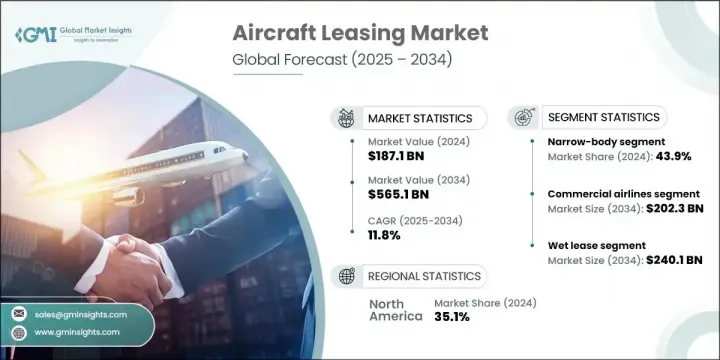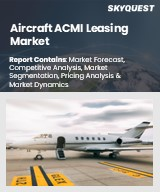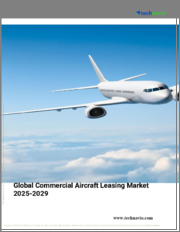
|
시장보고서
상품코드
1801837
항공기 리스 시장 : 기회, 성장 촉진요인, 산업 동향 분석 및 예측(2025-2034년)Aircraft Leasing Market Opportunity, Growth Drivers, Industry Trend Analysis, and Forecast 2025 - 2034 |
||||||
세계의 항공기 리스 시장은 2024년에 1,871억 달러로 평가되었으며, CAGR 11.8%로 성장할 전망이며 2034년에는 5,651억 달러에 이를 것으로 예측됩니다.
전 세계 항공사들은 유동성을 유지하면서 운영 유연성을 확보하기 위한 전략적 접근법으로 리스 모델을 점점 더 적극적으로 도입하고 있습니다. 이러한 전환을 통해 운영사는 직접 구매에 필요한 자본 지출 없이도 기단을 보다 효율적으로 최근화하고, 수요 변동에 적응하며, 신형 항공기를 도입할 수 있습니다. 리스는 항공사들이 재정적 부담을 지나치게 늘리지 않으면서도 시장 변화와 경쟁 압력에 신속히 대응할 수 있게 합니다.

전 세계 항공기 생산 분야의 공급 제약 요인(납기 지연 포함)은 리스 동향에 성장세를 부여하고 있습니다. 항공기 제조사들은 인력 부족, 제조 병목 현상, 자재 가용성 문제로 인해 지속적인 납기 지연에 직면하고 있으며, 이로 인해 항공사들은 리스 계약을 통해 운항 능력 공백을 메우고 있습니다. 리스는 네트워크 성능 유지와 지속 가능한 기단 업데이트를 위한 실행 가능한 단기-중기적 해결책을 제공합니다. OEM(원조제조업체)의 주문 잔고가 수년 후까지 이어지면서, 특히 최근적이고 연료 효율이 높은 모델을 중심으로 한 리스 항공기 수요가 지속적으로 증가하고 있습니다. 이는 유연하고 비용 효율적인 조달 방법으로서의 리스 역할을 강화하고 있습니다.
| 시장 범위 | |
|---|---|
| 시작 연도 | 2024년 |
| 예측 연도 | 2025-2034년 |
| 시작 금액 | 1,871억 달러 |
| 예측 금액 | 5,651억 달러 |
| CAGR | 11.8% |
내로우 바디 항공기 부문은 2024년에 43.9%의 점유율을 차지하며 빠른 회전율, 연료 효율성, 국내 및 지역 노선 전반에 걸친 다용도성으로 선호되었습니다. 이러한 항공기는 특히 항공 시장이 발전 중인 지역에서 고빈도 운항 및 노선 최적화에 유리한 점이 있습니다. 리스 업체들은 저비용 항공사와의 파트너십 강화와 경쟁력 있는 리스 조건 제공, 특히 좁은 동체 기체에 대한 조건을 통해 입지를 공고히 할 것으로 예상됩니다. 신속한 전개와 쉬운 교체를 지원하는 맞춤형 솔루션은 지역 확장이나 기단 갱신을 추구하는 항공사들의 지속적인 관심을 받고 있다.
습식 리스 부문은 2034년까지 2,401억 달러 규모에 이를 전망이다. 이 리스 구조는 항공기, 승무원, 정비, 보험을 포함하여 계절적 수요 급증 대응, 시험 노선 개설, 기단 가동 중단 시 서비스 유지에 이상적이다. 습식 리스는 장기적 의무를 최소화하면서 항공기에 즉시 접근할 수 있게 해주기 때문에, 특히 불안정하거나 빠르게 회복 중인 시장에서 그 가치가 입증되고 있습니다.
북미의 항공기 리스 2024년 점유율은 35.1%로, 2025년부터 2034년까지 연평균 11.4%의 성장률을 보일 전망입니다. 고급 항공 인프라와 디지털 기술에 대한 강조가 증가함에 따라, 이 지역은 혁신 촉진형 항공기 전략에서 계속 선도하고 있습니다. 항공사들은 예측 분석 및 데이터 플랫폼을 통합하여 항공기 가용성을 개선하고 정비 주기를 간소화하고 있습니다. 잘 규제된 환경과 항공 시스템에 대한 지속적인 투자 또한 지역 전반에 걸쳐 리스 채택률을 높이고 있습니다.
세계의 항공기 리스 시장의 주요 기업는 Air Lease Corporation, BOC Aviation, SMBC Aviation Capital, Avolon, AerCap 등을 포함하며, 이들 기업은 신흥 및 기존 항공사 시장에서 상당한 활동과 항공기 편대 확장을 촉진하고 있습니다. 항공기 리스 업계 기업들은 시장 점유율을 강화하기 위해 연료 효율이 높은 모델에 중점을 두고 좁은 동체 항공기와 넓은 동체 항공기 옵션을 모두 제공함으로써 편대 다각화를 강조하고 있습니다. 또한 지속가능성에 민감한 항공사들을 유치하기 위해 향후 저배출 항공기를 도입하며 환경 동향에 부응하고 있습니다. OEM과의 전략적 파트너십은 최근 기체 확보를 가속화하는 한편, 유연한 리스 계약은 기존 항공사와 저비용 항공사 모두를 유치하는 데 기여합니다.
목차
제1장 조사 방법
제2장 주요 요약
제3장 업계 인사이트
- 생태계 분석
- 공급자의 상황
- 이익률 분석
- 비용 구조
- 각 단계에서의 부가가치
- 밸류체인에 영향을 주는 요인
- 혁신
- 업계에 미치는 영향요인
- 성장 촉진요인
- 항공교통량 증가와 항공기 확장
- 저비용 항공사(LCC) 성장
- OEM 납품 지연 및 생산 제약
- 리스 관할권의 유리한 세금 및 규제 체계
- 다양한 금융 및 매각 후 리스백(SLB) 구조 접근성
- 업계의 잠재적 위험 및 과제
- 리스 회사의 높은 자본 집약도, 긴 회수 기간
- 잔존가치 리스크
- 시장 기회
- 지속 가능하고 연비 효율적인 차량에 대한 수요 증가
- 리스 관리에서의 디지털화 및 고급 분석 활용
- 헬리콥터 및 특수 항공기 리스 기회
- 중고 리스 및 중기 항공기 시장 성장 잠재력
- 성장 촉진요인
- 성장 가능성 분석
- 규제 상황
- 북미
- 유럽
- 아시아태평양
- 라틴아메리카
- 중동 및 아프리카
- Porter's Five Forces 분석
- PESTEL 분석
- 기술과 혁신의 상황
- 현재의 기술 동향
- 신흥기술
- 새로운 비즈니스 모델
- 규정 준수 요건
- 국방예산 분석
- 세계의 방위비 동향
- 지역 방위 예산 배분
- 북미
- 유럽
- 아시아태평양
- 중동 및 아프리카
- 라틴아메리카
- 주요 방위 현대화 프로그램
- 예산 예측(2025-2034년)
- 업계의 성장에 미치는 영향
- 국가별 방위 예산
- 공급 체인의 탄력
- 지정학적 분석
- 인재 분석
- 디지털 변혁
- 합병, 인수, 전략적 제휴 상황
- 위험 평가 및 관리
- 주요 계약 체결(2021-2024년)
제4장 경쟁 구도
- 소개
- 기업의 시장 점유율 분석
- 지역별
- 북미
- 유럽
- 아시아태평양
- 라틴아메리카
- 중동 및 아프리카
- 지역별
- 주요 기업의 경쟁 벤치마킹
- 재무실적의 비교
- 수익
- 이익률
- 연구개발
- 제품 포트폴리오 비교
- 제품 라인업의 넓이
- 기술
- 혁신
- 지리적 존재의 비교
- 세계 실적 분석
- 서비스 네트워크의 범위
- 지역별 시장 침투율
- 경쟁 포지셔닝 매트릭스
- 전략적 전망 매트릭스
- 재무실적의 비교
- 주요 발전(2021-2024년)
- 합병과 인수
- 파트너십 및 협업
- 기술 발전
- 확대 및 투자 전략
- 지속가능성에 대한 노력
- 디지털 변혁의 대처
- 신흥기업/스타트업기업경쟁 구도
제5장 시장 추계 및 예측 : 리스 유형별(2021-2034년)
- 주요 동향
- 습식 리스
- 건식 리스
- 습윤 리스
제6장 시장 추계 및 예측 : 항공기 유형별(2021-2034년)
- 주요 동향
- 내로우 바디
- 와이드 바디
- 지역 제트기
제7장 시장 추계 및 예측 : 리스 계약 기간별(2021-2034년)
- 주요 동향
- 단기(2년 미만)
- 중기(2-6년)
- 장기(6년 이상)
제8장 시장 추계 및 예측 : 최종 용도별(2021-2034년)
- 주요 동향
- 상업용 항공사
- 항공화물 운항회사
- 정부 및 방위
- 전세 항공기 운영회사
- 훈련 및 항공학교
- 기타
제9장 시장 추계 및 예측 : 지역별(2021-2034년)
- 주요 동향
- 북미
- 미국
- 캐나다
- 유럽
- 독일
- 영국
- 프랑스
- 이탈리아
- 스페인
- 네덜란드
- 아시아태평양
- 중국
- 인도
- 일본
- 호주
- 한국
- 라틴아메리카
- 브라질
- 멕시코
- 아르헨티나
- 중동 및 아프리카
- 남아프리카
- 사우디아라비아
- 아랍에미리트(UAE)
제10장 기업 프로파일
- 세계 주요 기업
- AerCap
- Air Lease Corporation
- SMBC Aviation Capital
- 지역별 주요 기업
- 북미
- Aircastle
- BBAM
- Jackson Square Aviation
- Merx Aviation Finance
- Sky Leasing
- 유럽
- AviaAM Leasing
- Macquarie AirFinance
- TrueNoord
- Zephyrus Aviation Capital
- 아시아태평양
- BOC Aviation
- CDB Aviation
- ALAFCO Aviation Lease and Finance Company
- 북미
- 틈새 기업/혁신 기업
- Avolon
- ACIA Aero Leasing
- Dubai Aerospace Enterprise
- Falko
The Global Aircraft Leasing Market was valued at USD 187.1 billion in 2024 and is estimated to grow at a CAGR of 11.8% to reach USD 565.1 billion by 2034. Airlines worldwide are increasingly embracing leasing models as a strategic approach to maintain liquidity while ensuring operational flexibility. This shift allows operators to modernize their fleets more efficiently, adapt to fluctuating demand, and introduce new-generation aircraft without the capital outlay required for direct purchases. Leasing enables carriers to respond swiftly to market changes and competitive pressure without overextending financially.

Global supply constraints in aircraft production, including delayed deliveries, have added momentum to the leasing trend. Aircraft manufacturers continue to face prolonged lead times due to workforce shortages, manufacturing bottlenecks, and material availability, leading airlines to fill capacity gaps through leasing arrangements. Leasing offers a viable short-to-medium-term solution for maintaining network performance and implementing sustainable fleet updates. As OEM backlogs extend years into the future, demand for leased aircraft-particularly modern, fuel-efficient models-continues to grow, reinforcing the role of leasing as a flexible and cost-effective procurement method.
| Market Scope | |
|---|---|
| Start Year | 2024 |
| Forecast Year | 2025-2034 |
| Start Value | $187.1 Billion |
| Forecast Value | $565.1 Billion |
| CAGR | 11.8% |
The narrow-body aircraft segment held a 43.9% share in 2024, favored for its quick turnaround, fuel efficiency, and versatility across domestic and regional routes. These aircraft are particularly beneficial for high-frequency operations and route optimization, especially in developing aviation markets. Lessors are expected to strengthen their position by focusing on partnerships with low-cost carriers and offering competitive leasing terms, especially for narrow-body fleets. Tailored solutions that support rapid deployment and easy replacement continue to attract airlines pursuing regional expansion or fleet renewal.
The wet lease segment will reach USD 240.1 billion by 2034. This leasing structure includes aircraft, crew, maintenance, and insurance, making it ideal for meeting seasonal capacity spikes, launching trial routes, or maintaining service during fleet downtimes. Wet leases offer operators immediate access to aircraft with minimal long-term obligations, proving especially valuable in unstable or fast-recovering markets.
North America Aircraft Leasing Market held 35.1% share in 2024 and will grow at a CAGR of 11.4% from 2025 to 2034. With its advanced aviation infrastructure and growing emphasis on digital technologies, the region continues to lead in innovation-driven fleet strategies. Airlines are integrating predictive analytics and data platforms to improve fleet availability and streamline maintenance cycles. A well-regulated environment and sustained investments into aviation systems also enhance leasing adoption rates across the region.
Major players in the Global Aircraft Leasing Market include Air Lease Corporation, BOC Aviation, SMBC Aviation Capital, Avolon, and AerCap, each driving substantial activity and fleet expansion across emerging and established airline markets. To gain a stronger foothold, companies in the aircraft leasing industry are emphasizing fleet diversification by offering both narrow- and wide-body aircraft options, with a focus on fuel-efficient models. They are also aligning with environmental trends by incorporating next-generation, lower-emission aircraft to appeal to sustainability-conscious carriers. Strategic partnerships with OEMs allow faster access to modern fleets, while flexible lease agreements help attract both legacy airlines and low-cost operators.
Table of Contents
Chapter 1 Methodology
- 1.1 Market scope and definition
- 1.2 Research design
- 1.2.1 Research approach
- 1.2.2 Data collection methods
- 1.3 Data mining sources
- 1.3.1 Global
- 1.3.2 Regional/Country
- 1.4 Base estimates and calculations
- 1.4.1 Base year calculation
- 1.4.2 Key trends for market estimation
- 1.5 Primary research and validation
- 1.5.1 Primary sources
- 1.6 Forecast model
- 1.7 Research assumptions and limitations
Chapter 2 Executive Summary
- 2.1 Industry 3600 synopsis, 2021 - 2034
- 2.2 Key market trends
- 2.2.1 Leasing type trends
- 2.2.2 Aircraft type trends
- 2.2.3 Lease tenure trends
- 2.2.4 End use trends
- 2.2.5 Regional trends
- 2.3 TAM analysis, 2025-2034
- 2.4 CXO perspectives: Strategic imperatives
- 2.4.1 Executive decision points
- 2.4.2 Critical success factors
- 2.5 Future outlook and strategic recommendations
Chapter 3 Industry Insights
- 3.1 Industry ecosystem analysis
- 3.1.1 Supplier landscape
- 3.1.2 Profit margin analysis
- 3.1.3 Cost structure
- 3.1.4 Value addition at each stage
- 3.1.5 Factor affecting the value chain
- 3.1.6 Disruptions
- 3.2 Industry impact forces
- 3.2.1 Growth drivers
- 3.2.1.1 Rising air traffic and fleet expansion
- 3.2.1.2 Growth of low-cost carriers (LCCs)
- 3.2.1.3 OEM delivery delays and production constraints
- 3.2.1.4 Favorable tax and regulatory frameworks in leasing jurisdictions
- 3.2.1.5 Access to diverse financing and sale-and-leaseback (SLB) structures
- 3.2.2 Industry pitfalls and challenges
- 3.2.2.1 High capital intensity and long payback period for lessors
- 3.2.2.2 Residual value risk due to technological obsolescence
- 3.2.3 Market opportunities
- 3.2.3.1 Growing demand for sustainable and fuel-efficient fleets
- 3.2.3.2 Digitalization and use of advanced analytics in lease management
- 3.2.3.3 Opportunities in helicopter and specialized aircraft leasing
- 3.2.3.4 Potential for growth in secondary leasing and mid-life aircraft markets
- 3.2.1 Growth drivers
- 3.3 Growth potential analysis
- 3.4 Regulatory landscape
- 3.4.1 North America
- 3.4.2 Europe
- 3.4.3 Asia Pacific
- 3.4.4 Latin America
- 3.4.5 Middle East & Africa
- 3.5 Porter’s analysis
- 3.6 PESTEL analysis
- 3.7 Technology and Innovation landscape
- 3.7.1 Current technological trends
- 3.7.2 Emerging technologies
- 3.8 Emerging business models
- 3.9 Compliance requirements
- 3.10 Defense budget analysis
- 3.11 Global defense spending trends
- 3.12 Regional defense budget allocation
- 3.12.1 North America
- 3.12.2 Europe
- 3.12.3 Asia Pacific
- 3.12.4 Middle East and Africa
- 3.12.5 Latin America
- 3.13 Key defense modernization programs
- 3.14 Budget forecast (2025-2034)
- 3.14.1 Impact on industry growth
- 3.14.2 Defense budgets by country
- 3.15 Supply chain resilience
- 3.16 Geopolitical analysis
- 3.17 Workforce analysis
- 3.18 Digital transformation
- 3.19 Mergers, acquisitions, and strategic partnerships landscape
- 3.20 Risk assessment and management
- 3.21 Major contract awards (2021-2024)
Chapter 4 Competitive Landscape, 2024
- 4.1 Introduction
- 4.2 Company market share analysis
- 4.2.1 By region
- 4.2.1.1 North America
- 4.2.1.2 Europe
- 4.2.1.3 Asia Pacific
- 4.2.1.4 Latin America
- 4.2.1.5 Middle East & Africa
- 4.2.1 By region
- 4.3 Competitive benchmarking of key players
- 4.3.1 Financial performance comparison
- 4.3.1.1 Revenue
- 4.3.1.2 Profit margin
- 4.3.1.3 R&D
- 4.3.2 Product portfolio comparison
- 4.3.2.1 Product range breadth
- 4.3.2.2 Technology
- 4.3.2.3 Innovation
- 4.3.3 Geographic presence comparison
- 4.3.3.1 Global footprint analysis
- 4.3.3.2 Service network coverage
- 4.3.3.3 Market penetration by region
- 4.3.4 Competitive positioning matrix
- 4.3.4.1 Leaders
- 4.3.4.2 Challengers
- 4.3.4.3 Followers
- 4.3.4.4 Niche players
- 4.3.5 Strategic outlook matrix
- 4.3.1 Financial performance comparison
- 4.4 Key developments, 2021-2024
- 4.4.1 Mergers and acquisitions
- 4.4.2 Partnerships and collaborations
- 4.4.3 Technological advancements
- 4.4.4 Expansion and investment strategies
- 4.4.5 Sustainability initiatives
- 4.4.6 Digital transformation initiatives
- 4.5 Emerging/ startup competitors landscape
Chapter 5 Market Estimates and Forecast, By Leasing Type, 2021 - 2034 (USD Billion)
- 5.1 Key trends
- 5.2 Wet lease
- 5.3 Dry lease
- 5.4 Damp lease
Chapter 6 Market Estimates and Forecast, By Aircraft Type, 2021 - 2034 (USD Billion)
- 6.1 Key trends
- 6.2 Narrow-body
- 6.3 Wide-body
- 6.4 Regional jets
Chapter 7 Market Estimates and Forecast, By Lease Tenure, 2021 - 2034 (USD Billion)
- 7.1 Key trends
- 7.2 Short-term (<2 years)
- 7.3 Medium-term (2-6 years)
- 7.4 Long-term (>6 years)
Chapter 8 Market Estimates and Forecast, By End Use, 2021 - 2034 (USD Billion)
- 8.1 Key trends
- 8.2 Commercial airlines
- 8.3 Air cargo operators
- 8.4 Government & defense
- 8.5 Charter operators
- 8.6 Training & aviation schools
- 8.7 Others
Chapter 9 Market Estimates & Forecast, By Region, 2021 - 2034 (USD Billion)
- 9.1 Key trends
- 9.2 North America
- 9.2.1 U.S.
- 9.2.2 Canada
- 9.3 Europe
- 9.3.1 Germany
- 9.3.2 UK
- 9.3.3 France
- 9.3.4 Italy
- 9.3.5 Spain
- 9.3.6 Netherlands
- 9.4 Asia Pacific
- 9.4.1 China
- 9.4.2 India
- 9.4.3 Japan
- 9.4.4 Australia
- 9.4.5 South Korea
- 9.5 Latin America
- 9.5.1 Brazil
- 9.5.2 Mexico
- 9.5.3 Argentina
- 9.6 MEA
- 9.6.1 South Africa
- 9.6.2 Saudi Arabia
- 9.6.3 UAE
Chapter 10 Company Profiles
- 10.1 Global Key Players
- 10.1.1 AerCap
- 10.1.2 Air Lease Corporation
- 10.1.3 SMBC Aviation Capital
- 10.2 Regional Key Players
- 10.2.1 North America
- 10.2.1.1 Aircastle
- 10.2.1.2 BBAM
- 10.2.1.3 Jackson Square Aviation
- 10.2.1.4 Merx Aviation Finance
- 10.2.1.5 Sky Leasing
- 10.2.2 Europe
- 10.2.2.1 AviaAM Leasing
- 10.2.2.2 Macquarie AirFinance
- 10.2.2.3 TrueNoord
- 10.2.2.4 Zephyrus Aviation Capital
- 10.2.3 APAC
- 10.2.3.1 BOC Aviation
- 10.2.3.2 CDB Aviation
- 10.2.3.3 ALAFCO Aviation Lease and Finance Company
- 10.2.1 North America
- 10.3 Niche Players / Disruptors
- 10.3.1 Avolon
- 10.3.2 ACIA Aero Leasing
- 10.3.3 Dubai Aerospace Enterprise
- 10.3.4 Falko














